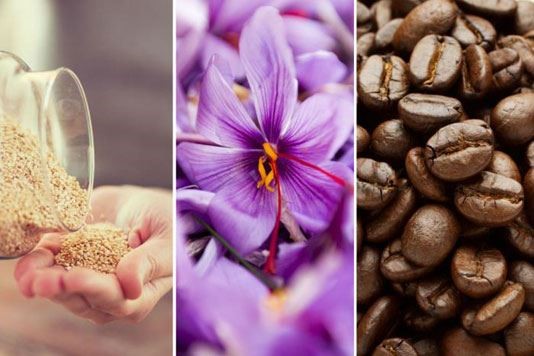The world's most expensive ingredients

From gourmet mushrooms to labour-intensive spices and indulgent white truffles sniffed out by trained pigs, check out our list of the most expensive ingredients from around the world.
Alba white truffle
Knobbled white truffles are a gourmet indulgence found in the Piedmont region of Northern Italy and their high price, around £130 an ounce, is due to their unpredictable growth habits. No one has been able to domesticate them, relying instead on trained dogs and pigs to sniff them out.
Ayam Cemani chicken
Ayam Cemani chickens, an unusual Indonesian breed, are all black right the way from their feathers and organs to their muscles. Believed to have magical powers, they are much sought-after in their native land and cost £1,600 for a chicken or £130 for a chick.
Beluga caviar
One of the most expensive ingredients in the world, ultra-rare beluga caviar is extremely difficult to come by, commanding huge prices whenever it’s available. It’s a delicacy of salt-cured fish eggs found in the Caspian, Adriatic and Black Seas, and is sold in small quantities for around £4,000.
Blowfish (fugu)
Fugu is a long-standing delicacy in Japan but parts of the unusual-looking fish are highly poisonous, so only highly-trained and licensed chefs are allowed to serve it. Fugu is banned within the European Union but available in the US, South Korea and Japan and a small fugu meal in Tokyo can cost up to 13,000 Yen, which is equivalent to £65.
Bluefin tuna
Bluefin tuna, which is known for its tender pink and red meat, is used in sushi. Although environmentalists regularly warn about the fish being an endangered species, suppliers can still get £2,200 for a mere pound.
Quinoa
Quinoa is the perfect example of the way food trends travel. A Peruvian staple for centuries, its price tripled from 2006-2013 as it gained rapid popularity worldwide. It grows at cool high altitudes at 2,500 to 4,000m, which makes it much more expensive for farmers to harvest than rice or wheat.
Jamon Ibérico De Bellota
The most expensive ham in the world comes from Ibérico hogs fed on acorns. Once butchered, the meat is hung for at least two years, producing dark red meat that’s sweet, nutty and melt-in-your-mouth tender. Expect to pay around £850 for 15 pounds of bone-in Jamon Ibérico De Bellota.
Kopi Luwak
Genuine Kopi Luwak is collected from the droppings of wild civit cats that prowl Indonesian coffee plantations at night, eating ripe coffee cherries. The cats can’t digest the beans, so workers collect their precious droppings. Highly prized and hard to come by, a kilo costs between £130-£260, sometimes more. It’s the world’s rarest, most flavourful and most expensive coffee.
Matcha green tea powder
High in antioxidants and also caffeine, matcha green tea powder is finely ground and can be used in baking, juices or for flavoring ice cream or other gourmet desserts. Expect to pay around £120-£130 per kilo of good quality matcha green tea powder.
Matsutake mushroom
Matsutake mushrooms are facing extinction in Japan’s Okinawa region due to an increase in nematodes, which will kill the trees these mushrooms grow under. The amount harvested has fallen by half. Still, there’s plenty of people still willing to shell out £650 per pound for their huge stems.
Vanilla
Pure vanilla is second only to saffron when it comes to the priciest spices. Madagascar and Indonesia are the largest producers but growing and harvesting it is very labour intensive. Just like chocolate and coffee, it’s expensive – six vanilla beans can cost £10.
Saffron
Iran is the world's main producer of saffron, producing 95% of the global demand. Each flower produces about three red stamens, which must be picked by hand. For every 150 flowers picked, only one gram of precious saffron is produced and can be sold for between £1,300 and £6,500 a pound.
To’ak chocolate
Prestigious To’ak chocolate is sold for £170 a bar, weighs just 1.5 ounces and contains an impressive 81% pure cacao, which is harvested from Ecuador. One of the reasons for the high price tag is that it contains a pure cocoa bean in the middle of the bar.
Kobe beef
Kobe beef comes from Wagyu cattle raised in the Hyogo region of Japan and is well-loved among carnivores for its rich flavour and melt-in-your-mouth texture. You’ll find it in steakhouses, sushi restaurants or at the butchers, where a four-ounce filet mignon costs around £33.
Japanese Densuke watermelon
The Japanese Densuke melon is a whopping 17-pound black watermelon. It’s hard, crisp and sweet to taste, but only about 65 of these prized fruits are harvested each year. Densuke melons are sometimes even auctioned off, and have been known to sell for as much as £2,500 each in Japan.
Nakazawa milk
Made in Japan, Nakazawa cow’s milk is collected just once a week at dawn to ensure it contains higher levels of melatonin, a hormone proven to help relieve stress. It’s bottled within six hours of extraction and costs £28 per quart.
Ruby Roman grapes
Grown in Japan’s Ishikawa Perfecture, top quality Ruby Roman grapes grow to the size of ping pong balls but are extremely rare. Sometimes only one bunch per year manages to meet the premium class standard and reaches up to £2,600, meaning each individual red grape costs £72.
Yubari King melons
Juicy and sweet, Japanese Yubari King melons are hybrids of two varieties of the more reasonably priced cantaloupes. Sold as pairs, they’re considered a lavish gift in Japan and a piece from a perfectly round, smooth Yubari King melon can be sold for £33-£65. At auction, a pair has been known to sell for an extortionate $26,000 (£17,000).
More tasty morsels:
Comments
Be the first to comment
Do you want to comment on this article? You need to be signed in for this feature